
Corn, commonly referred to as maize in indigenous cultures, is one of the world's most extensively cultivated crops, surpassed only by rice. Believed to have originated over 10,000 years ago in the mountain valleys of Central America, maize has made its way across the globe, with its cultivation now seen in virtually every part of the world.
Corn, commonly referred to as maize in indigenous cultures, is one of the world's most extensively cultivated crops, surpassed only by rice. Believed to have originated over 10,000 years ago in the mountain valleys of Central America, maize has made its way across the globe, with its cultivation now seen in virtually every part of the world.
With time, corn cultivation spread across the Americas, and into Europe where corn became a fundamental food source of in just 100 years after its arrival. Corn held more than just nutritional value for the indigenous people; it bore a profound cultural and spiritual significance. Many Native American tribes revered corn as a sacred entity, often incorporating it into their rituals and ceremonies. Corn was also an important symbol of community and was often shared among families and neighbors.
For numerous Native American communities across North and South America, corn constituted an essential part of their diet. In what is now the United States, a farming technique known as the Three Sisters method was prevalent. This approach involved the simultaneous cultivation of corn,, beans, and squash, with each plant providing distinct benefits to the others, creating a harmonious, sustainable farming system. The corn provided support for the beans to climb, while the beans added nitrogen to the soil, which benefited the corn and squash. The squash, in turn, provided shade and moisture retention for the other two crops.
Another traditional Native American planting method was the magic circle, in which a ring of corn plants was surrounded by other crops, such as beans and squash. The ring of corn provided a protective barrier for the other crops and helped to deter pests and weeds.
Another traditional Native American planting method was the magic circle, in which a ring of corn plants was surrounded by other crops, such as beans and squash. The ring of corn provided a protective barrier for the other crops and helped to deter pests and weeds.
Planting in mounds: This method involves creating small mounds of soil and planting several corn seeds in each mound. This allows for good drainage and helps to prevent waterlogging.
Planting in mounds: This method involves creating small mounds of soil and planting several corn seeds in each mound. This allows for good drainage and helps to prevent waterlogging.
Crop rotation: To prevent soil depletion and nutrient loss, our ancestors learned by trail and error to rotate their crops, by planting corn in one area one year and then switching to another crop like squash or beans the following year.
There are several different types of corn plants, each with its own unique characteristics and uses. One of these includes Dent corn:
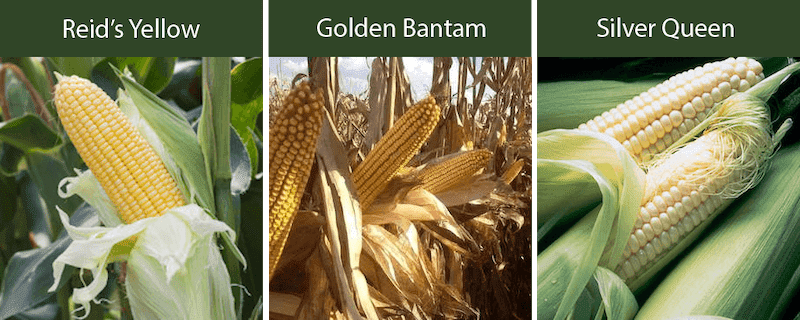
Dent corn, also known as field corn or cow corn, is the most commonly grown type of corn in the United States. Dent corn comes in several different varieties, each with its own unique characteristics and uses. In this article, we'll describe some of the main varieties of dent corn, including their stalk height, kernel color, cob size, ears per stalk, kernel texture, starch content, uses, soil composition preference, and sunshine days.
Reid's Yellow Dent Corn is one of the oldest and most popular varieties of dent corn. It is known for its tall stalks and large cobs, with 2-3 ears per stalk. The kernels are yellow in color and have a semi-flinty texture. Reid's Yellow Dent Corn has a high starch content and is primarily used for animal feed, cornmeal, corn syrup, and industrial uses.
Golden Bantam Corn is a popular variety of dent corn that is known for its sweet, tender kernels. It has a medium-sized stalk and small to medium-sized cobs, with 1-2 ears per stalk. The kernels are soft in texture and yellow in color. Golden Bantam Corn has a low to medium starch content and is primarily used for fresh eating, canning, freezing, and cornmeal.
Silver Queen Corn is a popular variety of dent corn that is known for its large, white kernels. It has tall stalks and large cobs, with 1-2 ears per stalk. The kernels have a semi-flinty texture and a high starch content. Silver Queen Corn is primarily used for fresh eating, canning, freezing, and cornmeal.
Stowell's Evergreen Corn is a classic variety of dent corn that is known for its tender, sweet kernels. It has tall stalks and large cobs, with 1-2 ears per stalk. The kernels are soft in texture and white in color.
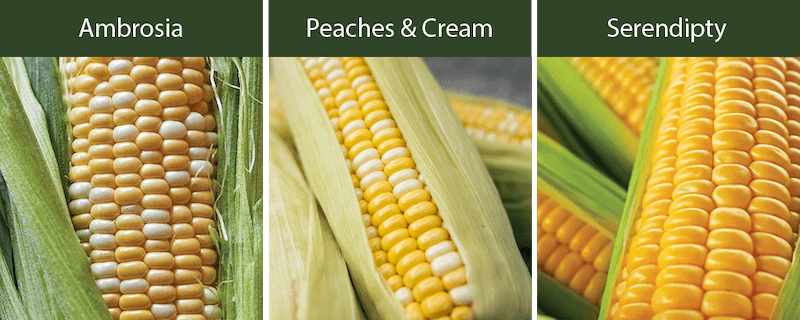
Sweet corn, a variant of corn consumed mainly as a vegetable, enjoys widespread popularity. Renowned for its soft, succulent kernels, it features prominently in numerous global cuisines. Various types of sweet corn exist, each boasting distinctive attributes and culinary applications. In this article, we'll describe some of the main varieties of sweet corn, including their stalk height, kernel color, cob size, ears per stalk, kernel texture, starch content, uses, soil composition preference, and sunshine days.
Peaches and Cream Corn is a popular variety of sweet corn that is known for its tender, sweet kernels. It has medium to tall stalks and medium to large cobs, with 1-2 ears per stalk. The kernels are a mix of yellow and white in color and have a tender texture. Peaches and Cream Corn has a medium starch content and is primarily used for fresh eating, canning, freezing, and roasting.
Jubilee Corn is a popular variety of sweet corn that is known for its large, yellow kernels. It has tall stalks and medium to large cobs, with 1-2 ears per stalk. The kernels have a tender texture and a medium starch content. Jubilee Corn is primarily used for fresh eating, canning, freezing, and roasting.
Serendipity Corn is a unique variety of sweet corn that is known for its white and yellow kernels. It has medium-sized stalks and cobs, with 1-2 ears per stalk. The kernels have a tender texture and a low starch content. Serendipity Corn is primarily used for fresh eating, canning, and freezing.
Butter and Sugar Corn is a popular variety of sweet corn that is known for its tender, sweet kernels. It has medium-sized stalks and cobs, with 1-2 ears per stalk. The kernels are a mix of yellow and white in color, which gives them a unique appearance. The kernels have a tender texture and a medium starch content. Butter and Sugar Corn is primarily used for fresh eating, canning, and freezing.
Honey and Cream Corn is a variety of sweet corn that is known for its low starch content and sweet, tender kernels. It has medium-sized stalks and cobs, with 1-2 ears per stalk. The kernels are a mix of yellow and white and tender Honey and Cream Corn is primarily used for fresh eating, canning, and freezing.
Ambrosia Corn is a popular variety of sweet corn that is known for its sweet, tender kernels. It has medium to tall stalks and medium-sized cobs, with 1-2 ears per stalk. The kernels are a mix of white and yellow in color and have a tender texture. Ambrosia Corn has a low to medium starch content and is primarily used for fresh eating, canning, and freezing.
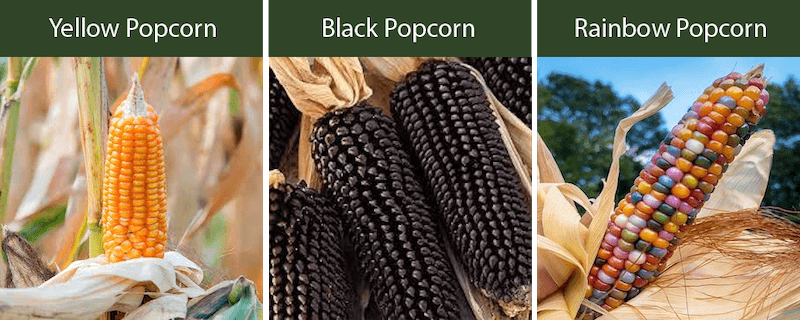
Popcorn is a type ofis available in several different varieties, each with its own unique popping characteristics. In this article, we'll describe some of the main varieties of popcorn, including their stalk height, kernel color, cob size, ears per stalk, kernel texture, starch content, uses, soil composition preference, and sunshine days.
Yellow popcorn is the most common variety of popcorn. It has medium-sized stalks and cobs, with 1-2 ears per stalk. The kernels are yellow in color and have a hard texture. Yellow popcorn has a high starch content and is primarily used as a snack food or decoration.
White popcorn is similar to yellow popcorn in terms of its characteristics and uses. It has medium-sized stalks and cobs, with 1-2 ears per stalk. The kernels are white in color and have a hard texture. White popcorn has a high starch content and is primarily used as a snack food or decoration.
Black popcorn is a unique variety of popcorn that has dark, almost black kernels. It has medium-sized stalks and cobs, with 1-2 ears per stalk. The kernels have a hard texture and a high starch content. Black popcorn is primarily used as a snack food or decoration.
Rainbow popcorn is a vibrant popcorn variant featuring kernels in an array of colors such as yellow, red, blue, and white. It has medium-sized stalks and cobs, with 1-2 ears per stalk. The kernels have a hard texture and a high starch content. Rainbow popcorn is primarily used as a snack food or decoration.
Mushroom popcorn is a unique variety of popcorn that has kernels that pop into a mushroom-like shape. It can come in white or yellow kernels and has small cobs with 1-2 ears per stalk. The kernels have a high starch content and are primarily used for making snack foods, confectionary, and caramel corn. Mushroom popcorn prefers well-drained soil with a pH between 6.0 and 7.0 and requires full sun.

FFlint corn, also referred to as Indian corn, serves primarily in the production of cornmeal, hominy, and masa. There are numerous distinct varieties of this corn, each featuring unique traits and applications. Here we examine characteristics such as stalk height, kernel color, size of the cob, number of ears per stalk, kernel texture, starch content, uses, preferred soil composition, and required sunshine days.
Blue Flint Corn is a popular variety of flint corn that has blue kernels. It has medium to tall stalks and medium to large cobs, with 1-2 ears per stalk. The kernels have a hard texture and a high starch content. Blue Flint Corn is primarily used for making cornmeal, hominy, and masa.
Yellow Flint Corn is a popular variety of flint corn that has yellow kernels. It has medium to tall stalks and medium to large cobs, with 1-2 ears per stalk. The kernels have a hard texture and a high starch content. Yellow Flint Corn is primarily used for making cornmeal, hominy, and masa.
Calico Flint Corn is a colorful variety of flint corn that has kernels in a variety of colors, including red, yellow, white, and black. It has medium to tall stalks and medium to large cobs, with 1-2 ears per stalk. The kernels have a hard texture and a high starch content. Calico Flint Corn is primarily used for making cornmeal, hominy, and masa, but can also be used for decorative purposes.
Hickory King Flint Corn is a tall variety of flint corn that has large cobs with 1-2 ears per stalk. It can come in white or yellow kernels and has a hard texture with a high starch content. Hickory King Flint Corn is primarily used for making cornmeal, hominy, and masa.
Painted Mountain Flint Corn is a colorful variety of flint corn that has kernels in a variety of colors, including red, yellow, and blue. It has short to medium-sized stalks and small to medium-sized cobs with 1 ear per stalk. The kernels have a hard texture and a high starch content. Painted Mountain Flint Corn is primarily used for making cornmeal and decorative purposes.
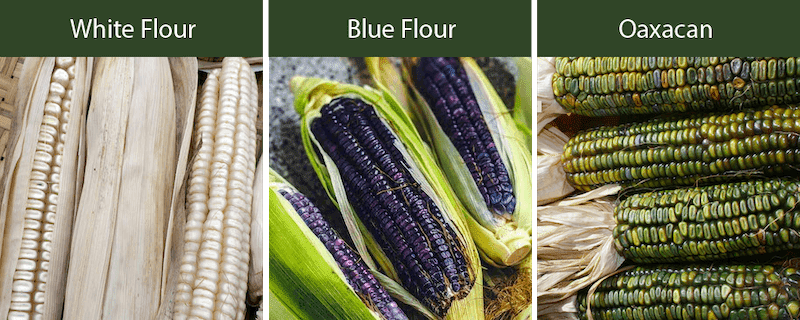
Flour corn, alternatively known as soft corn, distinguishes itself as a variety of corn possessing a greater proportion of soft starch compared to other corn types. It is often used for making cornmeal, flour, and tortillas. In this article, we'll describe some of the main varieties of flour corn, including their stalk height, kernel color, cob size, ears per stalk, kernel texture, starch content, uses, soil composition preference, and sunshine days.
White Flour Corn is a popular variety of flour corn that has white kernels. It has medium to tall stalks and medium-sized cobs, with 1-2 ears per stalk. The kernels have a soft texture and a high starch content. White Flour Corn is primarily used for making cornmeal, flour, and tortillas.
Blue Flour Corn is a variety of flour corn that has blue kernels. It has medium to tall stalks and medium-sized cobs, with 1-2 ears per stalk. The kernels have a soft texture and a high starch content. Blue Flour Corn is primarily used for making cornmeal, flour, and tortillas.
Yellow Flour Corn is a variety of flour corn that has yellow kernels. It has medium to tall stalks and medium-sized cobs, with 1-2 ears per stalk. The kernels have a soft texture and a high starch content. Yellow Flour Corn is primarily used for making cornmeal, flour, and tortillas.
Hopi Blue Flour Corn is a variety of flour corn that is primarily grown by the Hopi people in the southwestern United States. It has blue kernels and medium to tall stalks with medium-sized cobs and 1-2 ears per stalk. The kernels have a soft texture and a high starch content. Hopi Blue Flour Corn is primarily used for making cornmeal, flour, and tortillas.
Oaxacan Green Flour Corn is a unique variety of flour corn that has green kernels. It has medium to tall stalks and medium-sized cobs, with 1-2 ears per stalk. The kernels have a soft texture and a high starch content. Oaxacan Green Flour Corn is primarily used for making cornmeal, flour, and tortillas, and is especially popular in the Oaxaca region of Mexico.
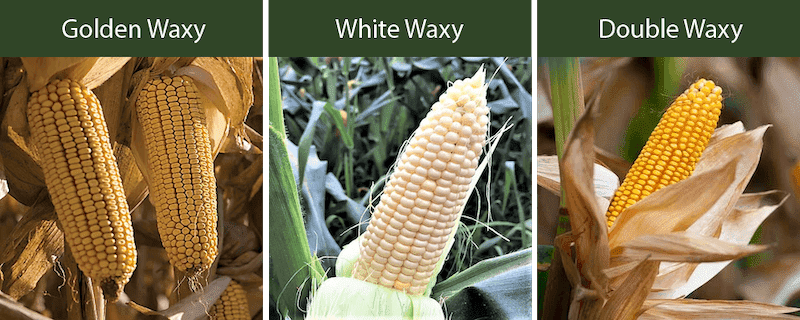
Waxy corn, often referred to as sweet corn or glutinous corn, is a corn variety characterized by its high amylopectin starch content. This attribute lends the corn a distinctive sticky and waxy texture. Below are some of the main varieties of waxy corn, including their stalk height, kernel color, cob size, ears per stalk, kernel texture, starch content, uses, soil composition preference, and sunshine days.
Golden Waxy Corn is a popular variety of waxy corn that has yellow kernels. It has medium to tall stalks and medium-sized cobs, with 1-2 ears per stalk. The kernels have a waxy texture and a high starch content. Golden Waxy Corn is primarily used for food products and industrial products.
White Waxy Corn is a variety of waxy corn that has white kernels. It has medium to tall stalks and medium-sized cobs, with 1-2 ears per stalk. The kernels have a waxy texture and a high starch content. White Waxy Corn is primarily used for food products and industrial products.
High Lysine Waxy Corn, a type of waxy corn, is notable for its rich lysine content. This quality renders it an exceptional choice for usage in animal feed. It can come in yellow or white kernels and has medium to tall stalks with medium-sized cobs and 1-2 ears per stalk. The kernels have a waxy texture and a high starch content, making it suitable for human food products as well.
Double Waxy Corn is a variety of waxy corn that has an even higher proportion of amylopectin starch than other varieties of waxy corn. It has yellow kernels and medium to tall stalks with medium-sized cobs and 1-2 ears per stalk. The kernels have an extremely waxy texture and a very high starch content, making it ideal for food products and industrial products. Pod corn: A type of corn that produces large, bulbous ears with irregularly shaped kernels. It is often used for decorative purposes, as well as in some traditional dishes in Mexico and Central America.
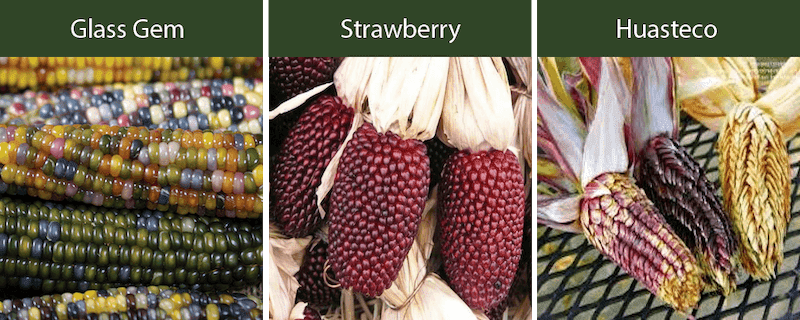
Pod corn, also known as tunicate corn, is a type of corn that has a unique characteristic of producing husks or pods that surround each kernel. In this article, we'll describe some of the main varieties of pod corn, including their stalk height, kernel color, cob size, ears per stalk, kernel texture, starch content, uses, soil composition preference, and sunshine days.
Strawberry Popcorn is a variety of pod corn that has red kernels. It has short to medium stalks and small to medium-sized cobs, with 1-2 ears per stalk. The kernels have a hard texture and a high starch content. Strawberry Popcorn is primarily used for making popcorn and decorative purposes.
Glass Gem Corn is a colorful variety of pod corn that has kernels in a variety of colors, including red, blue, yellow, and green. It has medium to tall stalks and medium-sized cobs with 1-2 ears per stalk. The kernels have a hard texture and a high starch content. Glass Gem Corn is primarily used for decorative purposes and can also be ground into cornmeal.
Painted Mountain Pod Corn is a colorful variety of pod corn that has kernels in a variety of colors, including red, yellow, and blue. It has short to medium stalks and small to medium-sized cobs with 1-2 ears per stalk. The kernels have a hard texture and a high starch content. Painted Mountain Pod Corn is primarily used for decorative purposes and can also be ground into cornmeal.
Huasteco Dent Pod Corn is a variety of pod corn that has multicolored kernels. It has medium to tall stalks and medium to large-sized cobs, with 1 ear per stalk. The kernels have a hard texture and a high starch content. Huasteco Dent Pod Corn is primarily used for decorative purposes and can also be used for food products.
Corn is a vital crop that is grown in the United States to meet the demands of both consumers and ethanol producers. The process of how corn plants process corn varieties grown by American corn farmers for both consumers and ethanol is an interesting topic that deserves a discussion.
The first step in the process is selecting the right corn varieties to grow. American corn farmers have access to a wide variety of corn seeds, and they choose the ones that are best suited for their location, soil type, climate, and market demand. Consumers have different preferences for the type of corn they want to buy, such as sweet corn, popcorn, or dent corn, which is used for animal feed and ethanol production.
After the corn is harvested, it is transported to processing corn plants where it is cleaned and prepared for further processing. The corn kernels are removed from the cob, and then sorted, cleaned, and inspected for quality. The kernels can be used to create a variety of products, such as cornmeal, flour, or oil, depending on the intended use.
For ethanol production, the corn kernels are first ground into a fine powder, known as cornmeal. This cornmeal is then mixed with water and heated to create a mash. Enzymes are added to the mash to break down the starch in the corn into sugar. The resulting mixture is cooled and yeast is added to begin the fermentation process. The fermentation process can take several days, during which time the yeast consumes the sugar in the mixture and produces ethanol and carbon dioxide.
Once the fermentation process is complete, the resulting mixture is distilled to separate the ethanol from the water and other impurities. The ethanol is then further purified and dehydrated to create fuel-grade ethanol that can be used in a variety of applications, such as fuel for vehicles and industrial processes.
For corn products intended for human consumption, such as cornmeal or flour, the kernels are milled into a fine powder. The resulting powder can be used to make a variety of corn-based products, such as tortillas, cornbread, or cereal.
The process of how corn plants process corn varieties grown by American corn farmers for both consumers and ethanol production is a complex and interesting one. It involves selecting the right corn varieties, cleaning and preparing the corn for processing, and using various methods to create corn-based products and ethanol. The end result is a crop that provides both food and fuel for the American people.
Ready to transform your land into a high-yield, sustainable farm? Let Crop Circle Farms design and build a custom, low-impact, and water-efficient farm tailored to your needs. Double your income and cut your costs in half! Contact Us
Help us expand our mission to revolutionize agriculture globally. We are seeking partners to implement Crop Circle Farms to feed people in need. Together, we can build scalable food production systems that save water, reduce costs, and feed thousands of people. Contact Growing To Give